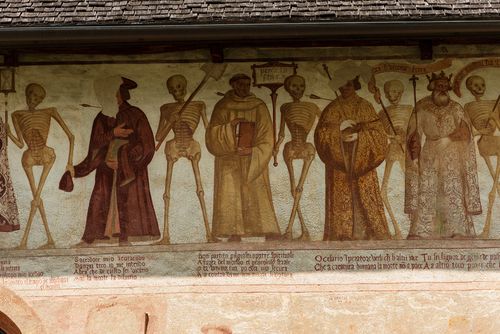 Since the dawn of time, humans have communicated and expressed themselves in many ways. When major tragedies occur, we react, trying to make sense of what seems to be nonsensical circumstances. The plethora of COVID-19 memes proves this point, but our ancestors affected by the Black Death did the exact same thing. Trying to cope with the widespread loss of human lives, artists created the Danse Macabre trope to remind us that death spares none of us in the end.
Since the dawn of time, humans have communicated and expressed themselves in many ways. When major tragedies occur, we react, trying to make sense of what seems to be nonsensical circumstances. The plethora of COVID-19 memes proves this point, but our ancestors affected by the Black Death did the exact same thing. Trying to cope with the widespread loss of human lives, artists created the Danse Macabre trope to remind us that death spares none of us in the end.
A Quick History of the Black Death
The Black Death went by many names: the bubonic plague, the Pestilence, and the Great Plague. They all refer to Yersinia pestis, a rod-shaped bacterium typically carried by rat fleas. Live Science contributor Winston Black explains that the first recorded instance of the Black Death may come from the Tibetan Plateau during the early 14th century, but prior pandemics include the Plague of Justinian during the middle of the sixth century.
However, the bacterium itself may have existed for thousands of years. The Atlantic’s Sarah Zhang reveals that genetic sequences from Yersinia pestis were found in the grave of a woman who died 4,900 years ago in what is now modern-day Sweden. Even worse, Yersinia pestis is the gift that keeps on giving: Black mentions multiple waves between the sixth and eighth centuries C.E., plus recurring epidemics between the 14th and 18th centuries, and yet another series of outbreaks between 1860 and 1960.
Harvard Health adds that the plague left telltale sores than turned into black scabs, earning it the “Black Death” nickname. The disease is transmitted through flea bites, direct contact with infected tissue, and breathing in bacteria from someone with a plague lung infection. This medieval scourge took out around a third of Europe’s population, killing up to 25 million people.
Dancing With Death in Medieval Art
Danse Macabre looks a little different from our COVID-19 memes, but it shares similar themes. The name is French for “dance of death,” and the imagery focused on what writer Bethany Corriveau Gotschall calls “the ever-present prospect of mortality.” The first known Danse Macabre image exists in a Parisian cemetery, a fresco dating to 1424 depicting human figures alongside a pack of dancing skeletons. The people came from many walks of life, from clerics and nobility to peasant farmers. The skeletons are grinning, Gotschall points out, but the humans clearly are not. She also notes that the fresco is in a space used for public gatherings, so everyone would have seen it.
Inspired by the original, artists throughout Europe created their own versions of the Dance Macabre. Frescos, murals, and mosaics appeared all over the continent. German artist Hans Holbein the Younger designed a woodcut series in the early 1500s. In his version, Death first shows up when Adam and Eve are kicked out of the Garden of Eden. Death appears for a final time at the Last Judgment when all humans must account for their earthly deeds. Holstein’s works were also social commentaries critical of the wealthy and powerful of his time. He shows the peasantry, ignored by the leaders and clergy charged with protecting them.
Danse Macabre in Modern Time
Does Danse Macabre portray death as a great equalizer? As kings, popes, merchants, and farmers are waltzed to their graves by dancing skeletons, that’s certainly one takeaway from the trope. Yet there’s also dark humor in these depictions. With multiple plague outbreaks stealing away friends and loved ones, people in the Middle Ages needed some sort of coping mechanism. “I’ve heard it said that we laugh at that which we don’t understand,” comments Death Café Columbus member Lizzy Miles. While we don’t want to avoid dealing with our sorrows, maybe laughter is sometimes the best medicine after all.
Add Your Comment